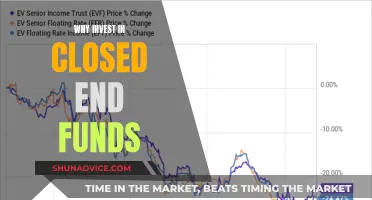
Investing in mutual funds is a great way to build a diversified portfolio without the extra cost or hassle. Mutual funds are investment vehicles that allow groups of investors to pool their money to purchase large portfolios of stocks, bonds, and other securities. They are managed by professionals and provide investors with exposure to hundreds of stocks or bonds, thereby diversifying their investment and reducing the risk of any single company causing a loss in value.
1. Decide on your mutual fund investment goals: Determine whether you are investing for the long term, such as retirement, or shorter-term goals like buying a home or a car.
2. Pick the right mutual fund strategy: Choose funds with an investment strategy tailored to your goals. For long-term goals, consider stock-based mutual funds, while for shorter-term goals, bond market mutual funds or high-yield savings accounts may be more suitable.
3. Research potential mutual funds: Use tools like the Mutual Fund Observer and Maxfunds to research different mutual funds and consider factors such as past performance, expense ratios, load fees, and management style.
4. Open an investment account: You may already have access to mutual funds through an employer-sponsored retirement plan. If not, you can open a brokerage account and invest through individual retirement accounts (IRAs), taxable brokerage accounts, or education savings accounts.
5. Purchase shares of mutual funds: Ensure you have enough money deposited in your investment account, keeping in mind that mutual funds may have higher investment minimums.
6. Set up a plan to invest regularly: Set up recurring investments to grow your wealth over time and benefit from dollar-cost averaging.
7. Consider your exit strategy: Eventually, you will want to sell your mutual fund shares to meet your financial goals. Be mindful of any backend loads or taxes you may owe on capital gains.
| Characteristics | Values |
|---|---|
| Investment type | Stocks, bonds, securities |
| Management | Professional fund managers |
| Diversification | Hundreds to thousands of individual securities |
| Risk | Lower risk due to diversification |
| Cost | Cost-efficient, annual fees, expense ratios, sales commissions, management fees |
| Returns | Dividends, interest income, portfolio distributions, capital gains distribution |
| Liquidity | Highly liquid, can be sold on any business day |
| Access | Online brokerage accounts, employer-sponsored retirement plans |
| Suitability | Long-term investment goals |
What You'll Learn

Picking the right mutual fund strategy
Identify your investment goals and risk tolerance:
Before choosing a mutual fund, it is important to understand your investment objectives. Are you investing for long-term capital gains or do you need current income? Is the money intended for college expenses or for retirement decades away? Your goals will help narrow down the vast array of available mutual funds. Additionally, consider your risk tolerance. Can you handle dramatic swings in portfolio value, or do you prefer a more conservative approach? Remember that risk and return are directly proportional, so balance your return expectations with your ability to tolerate risk.
Decide between active and passive management:
Mutual funds can be actively or passively managed. Actively managed funds have portfolio managers who actively research and select securities for the fund, aiming to outperform a benchmark index. These funds often come with higher fees. On the other hand, passively managed funds, or index funds, aim to replicate the performance of a benchmark index, resulting in lower fees. While index funds may not outperform the market, they tend to have lower costs and can still provide solid returns.
Evaluate fund managers and past performance:
When selecting an actively managed fund, it is crucial to assess the fund manager's track record. Consider whether the manager delivered results consistent with market returns and if the fund was more volatile than major indexes. Keep in mind that past performance does not guarantee future results, but evaluating a fund's historical trend can provide valuable insights.
Understand fees and expenses:
Mutual funds come with various fees that can impact your overall returns. These include expense ratios, sales charges or loads, redemption fees, and account maintenance fees. Actively managed funds tend to have higher fees, while passively managed funds often have lower expense ratios. Compare the fees across different funds to make an informed decision.
Diversify your portfolio:
Diversification is a key advantage of mutual funds. Consider investing in mutual funds that provide exposure to different sectors, company sizes, or geographic regions. This helps spread risk and potentially enhance returns. Look for funds with a mix of growth and value stocks, as well as a balance between large-cap, mid-cap, and small-cap companies.
Consider your time horizon:
Determine how long you plan to hold the mutual fund investment. Mutual funds typically have sales charges, so an investment horizon of at least five years is ideal to mitigate the impact of these charges. Additionally, consider your broader financial goals and whether you may need access to the funds in the short or long term.
Remember, investing in mutual funds involves risk, and there is no guarantee of returns. Conduct thorough research, understand the fees involved, and consider seeking advice from a financial professional before making any investment decisions.
Land vs Mutual Funds: Where Should You Invest?
You may want to see also

Researching potential mutual funds
Define Your Investment Objective:
Start by clarifying what you want to achieve with your investment. Are you saving for retirement, a new house, or a short-term goal like a vacation? Each scenario calls for a different investment approach and asset class. For instance, if you're investing for a vacation in a year, you may want to avoid risky biotech stocks. On the other hand, if you're planning for retirement decades away, a money market fund may not provide the desired returns. Knowing your investment objective will guide you towards the right categories of mutual funds.
Screening and Data Analysis:
Once you understand your investment goals, you can utilise screening tools to narrow down your options. Most brokerage accounts offer basic screeners that categorise funds. Additionally, websites like Morningstar.com and Lipperweb.com provide free extensive screeners. You can select a specific style, such as Domestic Large-Cap Value Stock Mutual Funds, and the screener will generate a list of funds with their corresponding statistics. When analysing the data, consider the following factors:
- Long-Term Performance: Evaluate the five- and ten-year performance of the fund. While past performance doesn't guarantee future results, it can be a useful indicator.
- Manager Tenure: Most mutual funds are actively managed, so consider the manager's tenure. If a fund has strong long-term returns but a new manager, the current manager may not be responsible for those gains.
- Fees and Costs: Pay close attention to the expense ratio, which is the ongoing fee paid to managers. While a 2% fee may seem insignificant initially, it can significantly impact your bottom line over time. Aim for funds with expense ratios below 1%. Also, consider front-end or back-end sales loads, which typically range from 1% to 5.75%.
- Minimum Investment: Investment minimums vary, so ensure you have sufficient funds to meet the requirements.
Checking the Prospectus:
The Investment Company Act of 1940 mandates that all mutual funds disclose information such as holdings, financial conditions, investment strategies, risks, and other pertinent details. Before investing, carefully review the fund's prospectus to understand its holdings, management commentaries, and issues requiring shareholder votes. This will provide insight into the fund's operations and help you make an informed decision.
Understanding Passive vs. Active Management:
Mutual funds can be passively or actively managed. Passively managed funds, often called index funds, aim to replicate the performance of a benchmark index. They generally have lower fees and don't trade their assets frequently. On the other hand, actively managed funds have portfolio managers who actively research and select securities for the fund. These funds often carry higher fees and aim to outperform the benchmark index. Consider your preferences and the associated costs when deciding between passive and active management.
Evaluating Managers and Past Results:
Researching a fund's past performance and the track record of its managers is essential. Ask yourself: Did the fund manager deliver results consistent with market returns? Was the fund more volatile than major indexes? Was there unusually high turnover that could impose costs and tax liabilities on investors? Answering these questions will help you assess the manager's capabilities and the fund's historical trends.
Selecting What Really Matters:
Instead of solely focusing on recent returns, consider factors that will influence future results. Morningstar, a leading investment research firm, rates mutual funds based on Process, Performance, People, Parent, and Price. They evaluate the fund's investment strategy, manager longevity, expense ratios, and other critical aspects. Remember, fees often have a strong correlation with strong performance, so keep that in mind when making your selection.
Investment Fund Balance Stagnation: Why It Happens
You may want to see also

Opening an investment account
If you don't have access to an employer-sponsored retirement account or are investing for a goal outside of retirement, you can invest in mutual funds by opening a brokerage account.
You can open a brokerage account with a bank or investment company. This will allow you to invest in a wide range of securities, including stocks, bonds, and mutual funds. When choosing a brokerage, consider factors such as affordability, fund choices, research and educational tools, and ease of use. Some popular brokerages include Fidelity and TD Ameritrade.
Another option is to buy mutual funds directly from the company that created the fund, such as Vanguard or BlackRock. However, this will limit your choice of funds. You can also work with a traditional financial advisor to purchase funds, but this may incur additional fees.
Once you've decided on a brokerage or fund company, you'll need to fill out an application with basic information such as your Social Security number and date of birth. You may also be asked about your investing experience and employment.
It's important to understand the different types of fees associated with mutual funds, as these can impact your returns over time. These include expense ratios, sales charges or loads, redemption fees, and other account fees.
When investing through a brokerage, you'll also want to consider the mix of funds that's right for you. Generally, a more conservative mix of investments is recommended for those closer to retirement age, while younger investors can take on more risk.
Additionally, you'll need to decide between active and passive funds. Active funds are managed by professionals who aim to beat the market but usually come with higher fees. Passive funds, on the other hand, aim to mimic the market and typically have lower fees.
Finally, consider the minimum investment amount required by the fund. Mutual funds may have higher investment minimums than other asset classes, so ensure you have enough funds deposited in your account before purchasing shares.
JPMorgan Growth Advantage Fund Class R6: Smart Investment Move?
You may want to see also

Understanding mutual fund fees
Annual Fund Operating Expenses
These are ongoing fees charged by the fund to cover its operating costs, including investment advisory fees, marketing and distribution expenses, brokerage fees, and legal and accounting fees. These expenses are typically paid out of fund assets rather than through separate fees charged directly to investors. The total annual fund operating expenses are expressed as a percentage of the fund's average net assets.
Management Fees
Management fees are paid to the fund's investment adviser or affiliates for managing the fund's investment portfolio and administrative fees. These fees are included in the annual fund operating expenses.
Distribution and/or Service (12b-1) Fees
These fees, also known as 12b-1 fees, are capped at 1% and are used to cover the costs of marketing and selling the fund, as well as shareholder services. They are included in the annual fund operating expenses.
Other Expenses
Other expenses may include custodial, legal, accounting, transfer agent, and other administrative costs. These are also part of the annual fund operating expenses.
Shareholder Fees
Shareholder fees are sales commissions and other one-time costs incurred when buying or selling mutual fund shares.
Sales Loads
Sales loads are commissions charged when purchasing or redeeming fund shares, similar to a broker's commission. There are two types: front-end sales loads, paid when buying shares, and back-end or deferred sales loads, paid when selling shares.
Redemption Fees
Some funds charge a redemption fee if you sell your shares within a specified period after purchasing them (usually 30 to 180 days). This fee is designed to discourage short-term trading and is limited to 2% by the SEC.
Exchange Fees
Exchange fees are charged by some funds when shareholders transfer their investment to another fund within the same fund group.
Account Fees
Account fees are maintenance fees charged by some funds, often imposed when an account balance falls below a certain minimum amount.
Purchase Fees
Purchase fees are charged by some funds when shareholders buy their shares. This is distinct from a front-end sales load, which is paid to the broker.
No-Load Funds
While some funds charge sales loads, others are "no-load" funds, which do not charge any type of sales load. However, no-load funds may still charge other fees such as purchase fees, redemption fees, exchange fees, and account fees.
Understanding the Impact of Fees
It's important to remember that a fund with high costs must perform better than a low-cost fund to generate the same returns for you. Even small differences in fees can significantly impact your long-term investment returns. Therefore, it's crucial to consider and compare the fee structures of different mutual funds before making investment decisions.
Vanguard Funds: Best Investment Options for Now
You may want to see also

Setting up a plan to keep investing regularly
- Determine your investment budget: Figure out how much money you can comfortably set aside each month for investing in mutual funds. A common guideline is to invest 15% of your gross income for retirement, but you may adjust this based on your financial goals and circumstances.
- Make it automatic: Set up automatic recurring investments. Most mutual fund companies and online brokerages allow you to automate your investments. This helps you stay disciplined and takes the emotion out of investing.
- Start early and invest regularly: Compounding returns can have a significant impact on your wealth over time. The earlier you start investing and the more consistently you contribute, the more you'll benefit from the power of compounding.
- Take advantage of dollar-cost averaging: Dollar-cost averaging is an investment strategy where you invest a fixed amount at regular intervals, regardless of the market conditions. This helps to smooth out the highs and lows of the market and reduces the risk of trying to time the market.
- Consider increasing your contributions over time: As your income increases, consider increasing your contributions to your mutual fund investments. This will help you stay on track with your financial goals and may be easier to manage if you're already accustomed to living on a certain amount.
- Monitor and rebalance your portfolio periodically: While mutual funds are a relatively hands-off investment, it's important to review your portfolio at least once a year. This will help you ensure that your investments are still aligned with your financial goals and risk tolerance. Make adjustments as necessary to maintain a balanced portfolio.
Utility Index Funds: When to Invest for Maximum Returns
You may want to see also
Frequently asked questions
Mutual funds are a collection of investors' money that fund managers use to invest in stocks, bonds, and other securities. They are a good investment option for the average investor since a single share of a mutual fund gives exposure to hundreds of stocks or bonds, diversifying investment dollars and reducing the risk.
Start with your savings goals to understand how aggressive you want your investments to be based on your risk tolerance and investment horizon. Then, determine the best asset allocation for your goals and select a mutual fund to help build your diversified portfolio. You might also want to consider whether you want an index fund or an actively managed fund.
Index funds, also known as passively managed funds, aim to follow a market benchmark like the S&P 500 Index or Dow Jones Industrial Average. Active funds, on the other hand, are managed by fund managers who handpick the fund's investments in an attempt to beat the market.
First, decide on your mutual fund investment goals and strategy. Then, research potential mutual funds to invest in, considering factors such as past performance, expense ratios, load fees, and management. Next, open an investment account through an employer-sponsored retirement plan, an individual retirement account (IRA), or a taxable brokerage account. Finally, purchase shares of the mutual funds you've selected, setting up a plan to invest regularly.
Some popular mutual fund companies include Vanguard, Fidelity, and American Funds.
Mutual funds offer professional management, diversification, and relatively low costs. They are also highly liquid, making it easy to buy or sell.







